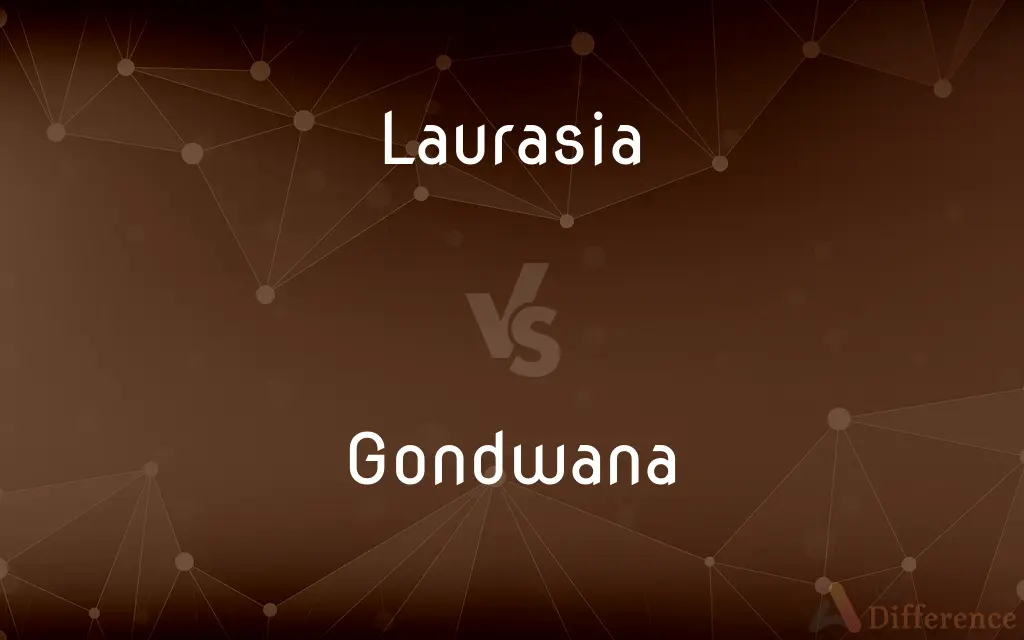Laurasia vs. Gondwana — What's the Difference?
By Tayyaba Rehman & Maham Liaqat — Updated on March 25, 2024
Laurasia was the northern supercontinent that formed part of the Pangaea supercontinent, whereas Gondwana comprised the southern landmasses.

Difference Between Laurasia and Gondwana
Table of Contents
ADVERTISEMENT
Key Differences
Laurasia, formed during the late Paleozoic and early Mesozoic eras, included what are now North America, Europe, and Asia (excluding India). It emerged from the breakup of the supercontinent Pangaea. On the other hand, Gondwana consisted of present-day South America, Africa, Arabia, Madagascar, India, Australia, and Antarctica, representing the southern counterpart of Pangaea.
Geologically, Laurasia's breakup led to the formation of the North Atlantic Ocean and the Arctic Ocean, shaping the northern continents as we know them today. Whereas, the disintegration of Gondwana played a crucial role in the formation of the South Atlantic, Indian Ocean, and the dispersal of the Gondwana continents, creating distinct biogeographic patterns across the southern hemisphere.
Climatically, during its existence, Laurasia experienced varied climates, from tropical to temperate, largely influenced by its positioning and breakup over time. Gondwana, with its vast expanse across the equator and towards the South Pole, exhibited more extreme climatic diversity, from tropical rainforests to the glaciated landscapes of Antarctica.
The flora and fauna of Laurasia were distinct, evolving separately from Gondwana due to the continental drift. This led to a diverse range of species adapted to the northern ecosystems. Conversely, Gondwana's wildlife evolved unique adaptations to its environments, contributing to the rich biodiversity of the southern continents, including marsupials in Australia and the unique flora of Madagascar.
Culturally and scientifically, the study of Laurasia and Gondwana has provided insights into the movement of continents, the history of life on Earth, and the process of plate tectonics. Understanding these supercontinents helps scientists reconstruct the past climatic conditions and predict future shifts in Earth's geological framework.
ADVERTISEMENT
Comparison Chart
Formation Era
Late Paleozoic to Early Mesozoic
Late Paleozoic to Early Mesozoic
Current Continents
North America, Europe, Asia (excluding India)
South America, Africa, Arabia, Madagascar, India, Australia, Antarctica
Geological Impact
Formation of the North Atlantic and Arctic Oceans
Formation of the South Atlantic and Indian Ocean
Climatic Diversity
Varied, from tropical to temperate
Extreme, from tropical rainforests to glaciated landscapes
Biodiversity
Distinct northern species
Unique adaptations in southern species
Compare with Definitions
Laurasia
The northern counterpart of Pangaea during the Mesozoic era.
Dinosaurs roamed across Laurasia, evidencing a connected ecosystem.
Gondwana
A supercontinent forming the southern part of Pangaea.
Gondwana included lands that are now several continents, including Antarctica and Australia.
Laurasia
A supercontinent that included North America, Europe, and Asia.
Laurasia's breakup significantly influenced the geological formation of the northern hemisphere.
Gondwana
Characterized by its extensive biodiverse ecosystems.
The ancient rainforests of Gondwana were ancestors to those in modern-day South America.
Laurasia
Home to unique flora and fauna.
The evolutionary history of Laurasian species shows distinct paths from those of Gondwana.
Gondwana
Diverse climates from equatorial to polar regions.
Gondwana's positioning contributed to the development of varied climatic zones.
Laurasia
Studied for insights into continental drift.
The analysis of Laurasia provides evidence supporting the theory of plate tectonics.
Gondwana
Influential in shaping Earth's geological history.
The breakup of Gondwana led to significant changes in the world's oceanic and atmospheric patterns.
Laurasia
Known for its diverse climatic conditions.
Laurasia experienced significant climatic shifts as it drifted northward.
Gondwana
Central to the study of evolutionary biology.
Fossils from Gondwana have provided crucial insights into the evolution of mammals and plants.
Laurasia
Laurasia (), was the more northern of two large landmasses that formed part of the Pangaea supercontinent from around 335 to 175 million years ago (Mya), the other being Gondwana. It separated from Gondwana 215 to 175 Mya (beginning in the late Triassic period) during the breakup of Pangaea, drifting farther north after the split and finally broke apart with the opening of the North Atlantic Ocean c.
Gondwana
Gondwana ( ) or Gondwanaland was a supercontinent that existed from the Neoproterozoic (about 550 million years ago) and began to break up during the Jurassic (about 180 million years ago), with the final stages of breakup, including the opening of the Drake Passage separating South America and Antarctica occurring during the Paleogene. Gondwana was not considered a supercontinent by the earliest definition, since the landmasses of Baltica, Laurentia, and Siberia were separated from it.It was formed by the accretion of several cratons.
Laurasia
The supercontinent of the Northern Hemisphere that, according to the theory of plate tectonics, broke up into North America, Greenland, Europe, and Asia except for the Indian subcontinent.
Gondwana
The supercontinent of the Southern Hemisphere that, according to the theory of plate tectonics, broke up into India, Australia, Antarctica, Africa, and South America.
Laurasia
A hypothetical continent that (according to plate tectonic theory) broke up later into North America and Europe and Asia
Common Curiosities
What was Laurasia?
Laurasia was the northern supercontinent that, along with Gondwana, made up the larger supercontinent Pangaea.
What continents made up Gondwana?
Gondwana consisted of modern-day South America, Africa, Arabia, Madagascar, India, Australia, and Antarctica.
When did Laurasia and Gondwana exist?
Both existed from the Late Paleozoic to the Early Mesozoic eras.
How did Laurasia's climate compare to Gondwana's?
Laurasia had varied climates from tropical to temperate, while Gondwana had a wider range, including tropical and glaciated landscapes.
What is the significance of Laurasia and Gondwana in evolutionary biology?
They offer insights into how species evolved differently due to geographic isolation.
Did dinosaurs exist on both Laurasia and Gondwana?
Yes, dinosaurs inhabited both supercontinents, showcasing a rich and varied prehistoric life.
How are Laurasia and Gondwana relevant to plate tectonics?
Their formation and breakup are key examples of plate tectonics in action, demonstrating how continents move and change over time.
How did Laurasia and Gondwana contribute to biodiversity?
The separation of Laurasia and Gondwana led to isolated evolution, contributing to the distinct biodiversity of the northern and southern hemispheres.
What caused the breakup of Laurasia and Gondwana?
The breakup was caused by the movement of tectonic plates beneath the Earth's surface.
What role do Laurasia and Gondwana play in understanding Earth's history?
Studying these supercontinents helps scientists understand continental drift, past climates, and evolutionary biology.
What evidence supports the existence of Laurasia and Gondwana?
Geological, fossil, and climatic data provide evidence of these ancient landmasses.
Did the breakup of Laurasia and Gondwana affect global climate?
Yes, the rearrangement of the continents affected ocean currents and atmospheric patterns, impacting the global climate.
How did the breakup of Gondwana influence ocean currents?
The formation of new ocean basins and the positioning of continents altered global ocean currents, affecting climate and marine life.
Can species from Laurasia and Gondwana still be distinguished today?
Yes, the evolutionary lineage of many species can be traced back to their origins on either Laurasia or Gondwana.
What discoveries have been made about Laurasia and Gondwana in recent years?
Ongoing research has provided deeper insights into their geological history, climate, and the evolution of life on Earth.
Share Your Discovery

Previous Comparison
Stand vs. Stood
Next Comparison
Ppm vs. BpmAuthor Spotlight
Written by
Tayyaba RehmanTayyaba Rehman is a distinguished writer, currently serving as a primary contributor to askdifference.com. As a researcher in semantics and etymology, Tayyaba's passion for the complexity of languages and their distinctions has found a perfect home on the platform. Tayyaba delves into the intricacies of language, distinguishing between commonly confused words and phrases, thereby providing clarity for readers worldwide.
Co-written by
Maham Liaqat















































